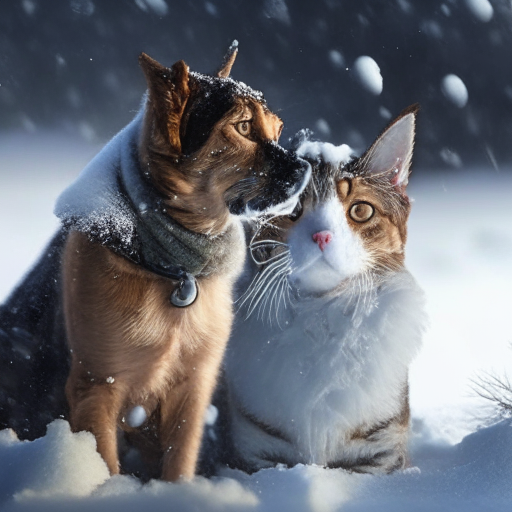Effective Strategies to Keep Your Pets Safe and Cozy During Winter Weather
As dedicated and affectionate pet owners, it is our responsibility to prioritize the health and safety of our beloved furry companions, especially during the cold winter months. The winter season brings various risks and challenges that can affect the well-being of our pets, particularly dogs and cats who may find it difficult to cope with the dropping temperatures. However, by arming ourselves with the right knowledge and implementing proactive strategies, we can create an environment that not only safeguards their health but also ensures their warmth and comfort. In this blog post, we will delve into essential tips and actionable approaches to help you navigate the winter season effectively, ensuring your cherished pets are protected from the harsh cold. Let’s explore these vital techniques for keeping your pets safe and cozy during winter.

Evaluate Your Pet’s Cold Weather Tolerance to Ensure Their Comfort
As winter approaches, it becomes increasingly important for pet owners to remain vigilant in monitoring the health and well-being of their furry companions. Just like humans, animals exhibit varying levels of tolerance to cold weather, which can be influenced by several factors such as breed, age, and overall health status. This section emphasizes the significance of understanding your pet’s unique cold tolerance levels, particularly concerning breed-specific characteristics. By gaining insights into your pet’s individual needs, you can empower yourself to make informed decisions that enhance their safety and comfort during the winter months, ensuring they remain happy and healthy throughout the chilly season.
- Recognizing Diverse Breeds and Their Unique Needs:
- Natural Adaptations: Each dog breed has evolved with specific traits that enable them to thrive in different climates. For example, breeds like Huskies and Malamutes possess thick fur and sturdy physiques, making them ideal for cold weather. Conversely, breeds such as Greyhounds and Chihuahuas may lack sufficient insulation to endure frigid temperatures, highlighting the necessity of providing them with additional protection against the cold.
- Understanding Breed-Specific Characteristics: Dedicating time to research and comprehend your pet’s breed characteristics is essential. This knowledge equips you to anticipate their needs effectively and implement the necessary precautions to keep them safe, warm, and comfortable throughout the winter season. Recognizing their unique vulnerabilities allows for customized care and a better quality of life during colder months.
- Evaluating Your Pet’s Individual Cold Tolerance:
- Observation is Key: Paying close attention to your pet’s behavior during varied weather conditions is vital. Signs of discomfort, such as shivering, reluctance to venture outdoors, or seeking warmer spots in the house, can indicate their level of cold tolerance. By identifying these signs early on, you can take proactive measures to prevent any potential issues before they escalate, ensuring your pet remains comfortable and safe.
- Medical Considerations: It is important to note that cold tolerance levels may vary for older pets, as well as those with pre-existing health conditions or recently adopted animals. Consulting your veterinarian can offer invaluable insights into specific precautions or considerations that should be taken based on your pet’s health profile. This guidance is essential for ensuring your pet's health and safety throughout the winter.
- Providing Extra Care for Sensitive Breeds:
- Protective Clothing: Investing in high-quality pet apparel, such as sweaters or jackets, becomes especially important for breeds with shorter fur or lower cold tolerance. These garments serve as an additional layer of insulation, ensuring your pet stays cozy and comfortable during outdoor excursions or playtime in the snow. Properly fitted clothing can significantly enhance your pet's winter experience.
- Limiting Outdoor Exposure: On exceptionally cold days, it is advisable to keep your pet indoors, especially if they are sensitive to low temperatures. Opt for shorter walks and create a warm indoor environment equipped with cozy bedding or blankets where they can snuggle and feel secure. This approach ensures their comfort and safety while minimizing the risks of cold-related stress.
- Creating a Cozy Indoor Sanctuary for Your Pets:
- Warm Bedding: Providing your pet with a warm and comfortable bed positioned away from drafts is essential. Adding extra blankets or pillows can significantly enhance insulation, offering additional comfort during those frigid winter nights. A cozy sleeping space guarantees that your pet has a secure and inviting place to rest and recuperate.
- Monitoring Indoor Temperatures: Maintaining a cozy temperature in your home is crucial, especially if you are away for extended periods. Utilizing programmable thermostats can help sustain a warm environment for your pet, even when you’re not at home, ensuring they remain comfortable and protected from the chill.
Understanding your pet’s cold tolerance is a vital aspect of responsible pet ownership, particularly during the winter months. By recognizing the unique demands of your pet’s breed and their individual characteristics, you can take proactive steps to ensure their safety, comfort, and overall health. Whether it’s investing in protective clothing, adjusting outdoor activities, or creating a warm indoor environment, a little extra care can significantly enhance your pet’s well-being during the colder weather.
Maximize Indoor Time to Shield Your Pets from Severe Cold
One of the most effective strategies for ensuring your pets' safety from the harsh winter cold is to keep them indoors as much as possible. While it is imperative for dogs to enjoy outdoor time for exercise and bathroom breaks, limiting their exposure to extremely cold or inclement weather is crucial for their health and well-being. If your pet must remain outside for any reason, it is vital to ensure they have access to a warm, insulated shelter filled with clean, dry bedding that provides protection from the elements. By creating a safe refuge, you will help guarantee their comfort and safety in chilly conditions.
Equip Your Pets with Suitable Attire for Outdoor Adventures
For pets that enjoy outdoor activities such as walks or hikes, dressing them appropriately can greatly enhance their warmth and protection against the cold. Investing in a well-fitting winter coat or jumper that covers their entire body is essential, particularly for areas with less fur, such as the chest and belly. In addition, consider providing protective boots to shield their paws from ice, salt, and harmful chemicals that may be present on roads and sidewalks. Proper attire is crucial to ensuring your pet stays safe and comfortable during their winter outings, allowing them to enjoy the season without discomfort.
Be Aware of Warning Signs for Frostbite and Hypothermia in Your Pets
Pets face serious risks of developing conditions such as frostbite and hypothermia if they are exposed to extreme cold for extended periods of time. Frostbite occurs when skin and underlying tissues freeze, potentially leading to severe tissue damage. Symptoms of frostbite include pain, swelling, and skin discoloration, where the affected areas may appear pale or bluish. Conversely, hypothermia represents a dangerous drop in body temperature, manifesting through signs such as lethargy, shivering, weakness, and even loss of consciousness. If you suspect your pet may be suffering from frostbite or hypothermia, it is crucial to seek emergency veterinary care immediately and monitor them closely for any concerning symptoms.
Keep Your Pets Safe from Antifreeze Hazards
Using antifreeze during the winter months is a common practice to prevent vehicles from freezing; however, it presents a significant threat to pets. The sweet taste of antifreeze can, unfortunately, attract animals, resulting in unintentional ingestion of this toxic substance. Ethylene glycol, a primary component in antifreeze, is highly toxic and can lead to severe kidney failure and even death. Always store antifreeze securely out of your pets’ reach, promptly clean up any spills, and explore pet-safe alternatives to help keep your furry friends safe from this hazardous material, ensuring their health and safety.
Ensure Your Pets Stay Hydrated During Cold Months
Maintaining proper hydration is just as critical for pets during winter as it is during warmer months. The dry winter air and indoor heating systems can contribute to dehydration, even when temperatures are low. It is essential to provide your pets with fresh, clean water at all times to encourage hydration. If your pet seems hesitant to drink cold water, consider offering lukewarm water or a bowl of heated water to stimulate their interest in drinking, helping to prevent discomfort from cold temperatures. Keeping your pets hydrated is vital for their health, even in the winter.
Create a Warm and Inviting Sleeping Area for Your Pets
Providing a cozy sleeping area for your pets during the cold weather is crucial for their comfort and overall well-being. Consider investing in a warm bed with extra blankets or bedding to insulate them from the cold floor. Utilizing elevated beds or thermal pads can also help keep your pets off the chilly ground while providing additional warmth. A comfortable sleeping space ensures that your furry companions have a safe and inviting haven to rest and recharge during the winter nights, promoting their overall health and happiness.
Exercise Caution with Heaters and Fireplaces Around Your Pets
While heaters and fireplaces can effectively warm your home during winter, they can also pose significant hazards to your pets if not used safely. Ensure space heaters are positioned securely and out of reach of curious pets to prevent accidental burns or tip-overs. Always supervise your pets when they are in the same room as heaters or fireplaces, and consider using protective screens around fireplaces to keep your pets safe from open flames and potential injuries. Implementing these precautions can safeguard your furry friends from heat-related accidents, allowing you to maintain a warm and safe environment.
Prioritize Paw Care and Drying After Outdoor Activities
During winter, it is essential to protect your pets’ paws from ice, salt, and chemical residues that can cause irritation or injury. After each outdoor excursion, gently wipe your pet’s paws with a warm, damp cloth to remove any salt or chemicals they may have picked up. Additionally, consider using pet-safe paw balms or protective wax to moisturize their paw pads and create a barrier against harsh winter conditions. Prioritizing paw care helps ensure your pets remain comfortable and healthy throughout the winter season, allowing them to enjoy their outdoor activities without discomfort.
Maintain a Consistent Exercise Routine for Your Pets Despite Winter Challenges
Keeping your pets engaged in a regular exercise routine is vital for their physical and mental health, even during the colder months. However, it’s important to be mindful of weather conditions before heading outdoors. On particularly frigid days, opt for shorter walks and aim to go outside during the warmer parts of the day, such as midday. If the weather is unfavorable, ensure your pets stay mentally stimulated and physically active by engaging them in fun indoor activities that promote exercise and bonding, helping to combat winter lethargy and ensuring they remain happy and healthy.
The post Protecting Your Pets in Chilly Conditions: Essential Tips appeared first on Survival Bite.
The Article Essential Tips for Protecting Pets in Cold Weather Was Found On https://limitsofstrategy.com


What a timely and important reminder for all pet owners! I love how you emphasize evaluating each pet’s cold weather tolerance—this is often overlooked. For example, my little Chihuahua struggles in the cold much more than my larger dogs, who seem to thrive even in the snow. It’s fascinating to see how different breeds handle winter weather due to their size and coat types.
It’s interesting how each pet really has its unique vibe when it comes to cold weather. Your experience with your Chihuahua is a great example of how size and coat types play such a big role in a dog’s comfort. Smaller dogs, especially those with shorter coats, really do feel the chill more, while larger breeds often have a natural insulation that helps them thrive in colder temperatures.
You make such a great point about breed differences in cold weather tolerance. It’s interesting to see how a Chihuahua can feel the chill much more than large breeds. They’ve just got a lot less insulation, right? Smaller dogs often lack that protective layer of fur, making them more sensitive to the cold. On the other hand, larger dogs with thicker coats tend to revel in winter weather, which can be quite amusing to watch.
Your emphasis on evaluating a pet’s cold weather tolerance resonates with me deeply. In my experience with my senior dog, I found that even brief exposure to frigid temperatures could be uncomfortable for her. Investing in a well-fitted winter coat made a significant difference in keeping her warm on walks, illustrating how small adjustments can greatly impact our pets’ comfort.
I can really relate to your experience with your senior dog. It’s amazing how much more sensitive they become to temperature as they age, isn’t it? That small adjustment, like investing in a good winter coat, can make such a difference in their comfort—not just outside, but in how they feel overall.
While the emphasis on winter safety for pets is crucial, I think it’s important to consider how individual breeds respond differently to cold weather. For example, while a Siberian Husky might thrive in winter conditions, a Chihuahua could struggle immensely. This highlights the need for tailored approaches based on a pet’s specific traits. Furthermore, I wonder how advancements in pet tech, like smart collars with temperature alerts, can help us monitor our pets in real-time during these colder months. Striking a balance between outdoor activity and warmth can be challenging, and I believe more focus should be given to how we can integrate tech solutions alongside traditional care strategies to ensure their comfort and safety. What are others’ thoughts on using technology to enhance winter care for pets?
You’ve raised some important points about how individual breeds handle cold weather. It’s true that smaller dogs like Chihuahuas can have a tough time, while breeds like Huskies seem right at home in the snow. Tailoring our approaches based on a pet’s unique traits is crucial for their well-being during the winter months.